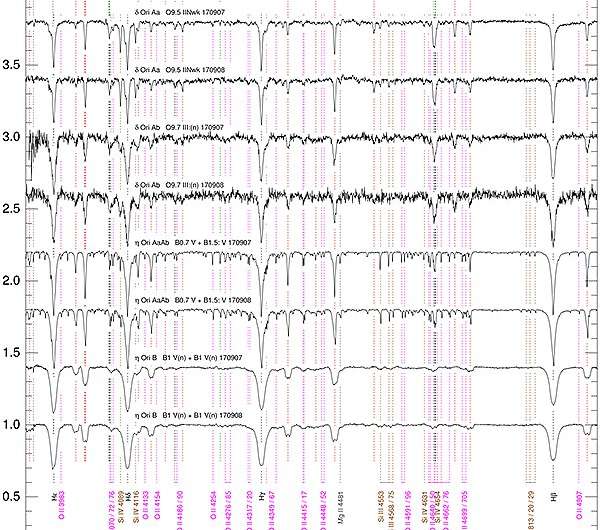First results from Lucky Spectroscopy, an equivalent technique to Lucky Imaging

The Galactic O-Star Spectroscopic Survey (GOSSS) is acquiring blue-violet spectroscopy of all optically accessible O stars in the Galaxy at resolution ~2500 and signal-to-noise ratio S/N > 200. To date, data from a total of 590 O stars has been published.
O stars love company and few (if any) of them are born completely isolated. As a result, their multiplicity fraction, both visual and spectroscopic, is close to one. This characteristic can be a blessing, allowing for the measurement of masses from their orbital motions, but most of the time it is also a curse. Multiplicity can be hard to identify and resolve (spatially and spectroscopically), and its hidden nature introduces biases when calculating properties such as the initial mass function. It also produces spectral peculiarities that may be mistaken for unique, intrinsic characteristics of the targets.
Lucky Imaging is a high-spatial resolution, passive imaging technique that takes a large number of short exposures and selects those with the best quality. It combines these best-quality exposures to produce a final result with a full width at half maximum (FWHM) much better than the long-exposure seeing.
In a strict sense, Lucky Imaging requires that one reaches the diffraction limit, and this places a number of observational restrictions: (i) z and i bands are preferred over shorter wavelengths, (ii) a 2-4 m telescope aperture is optimal because smaller telescopes yield larger diffraction-limited point-spread functions, and larger telescopes have a lower probability of producing good images, and (iii) the integration time must be at least similar to the atmospheric coherence time determined by turbulence.

In a looser sense, we can still call Lucky Imaging a setup in which some of these requirements are not met, yielding a final product with a FWHM improved over that of a long exposure, but which does not reach the diffraction limit.
Following the principles of Lucky Imaging, a team of astronomers led by Jesús Maíz Apellániz (Centro de Astrobiología, Madrid) obtained Lucky Spectroscopy for five multiple massive-star systems on the nights of 2017 September 7 and 8. The spectra were obtained with the standard GOSSS configuration using ISIS on the William Herschel Telescope, with three modifications to allow for lucky spatial separation of the individual component spectra:
- A slit width of 0.5 arcsec width was used, instead of the standard 0.9 arcsec to increase the spectral resolution.
- A narrow window of 166 pixels (33.2 arcsec on sky) in the spatial direction was used to read the detector in just 15 seconds.
- Either 100 or 110 short exposures of 0.1 s or 1.0 s each were obtained for each target.
The results are shown in the accompanying figure. The spectra of the δ Ori Aa+Ab components are the first ever obtained of the component stars individually in the optical wavelength range, while the spectra of σ Ori AaAb+B are the first ever detected individually in any wavelength range.
More information: J. Maíz Apellániz et al. Lucky Spectroscopy, an equivalent technique to Lucky Imaging, Astronomy & Astrophysics (2018). DOI: 10.1051/0004-6361/201832885
J. Maíz Apellániz et al. THE GALACTIC O-STAR SPECTROSCOPIC SURVEY (GOSSS). III. 142 ADDITIONAL O-TYPE SYSTEMS, The Astrophysical Journal Supplement Series (2016). DOI: 10.3847/0067-0049/224/1/4
Journal information: Astronomy & Astrophysics
Provided by Isaac Newton Group of Telescopes



















